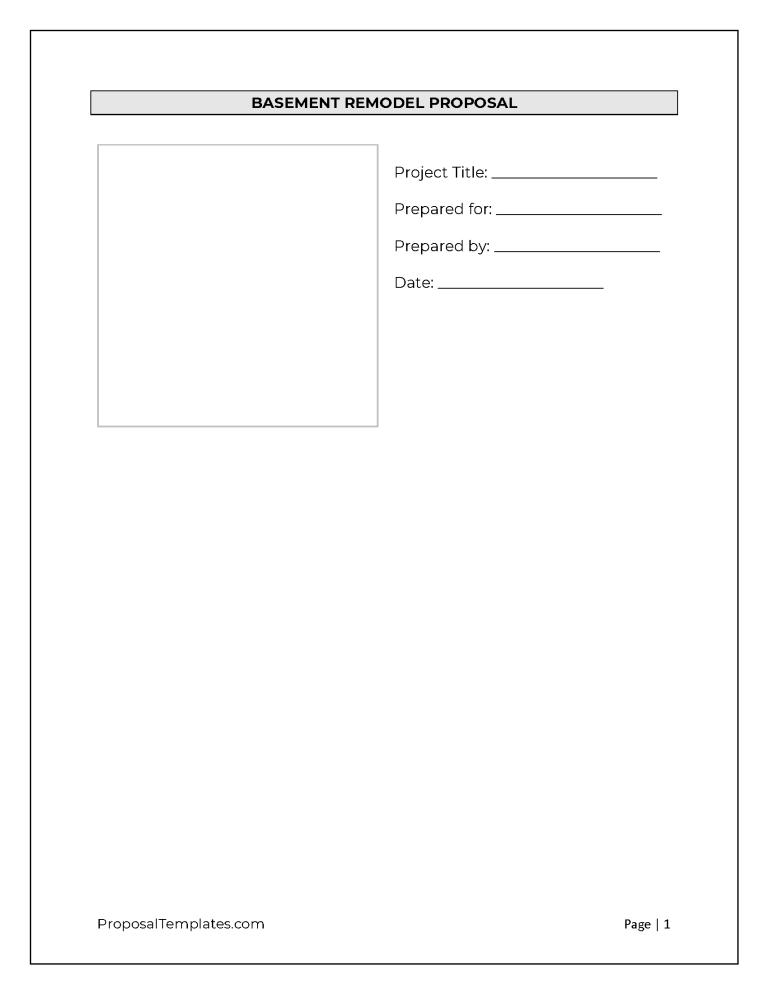A basement remodel proposal is an offering by a contractor to renovate a basement for payment. It should include the specific materials that should be used and the labor costs. In a renovation proposal, payments are generally made throughout the term of the construction until complete.
Types Of Basement Remodel Proposal (5)
- Carpeting Basement Remodel Proposal – This proposal is geared toward a basement project that specifically centers on replacing or installing carpets, calling for a substantial number of choices in materials in its presentation.
- Entertainment Basement Remodel Proposal – Basement Remodel Proposal – The proposal that is sent to basement remodeling clients requiring an entertainment theme (i.e., home movie theaters) featuring a pitch that balances design, technology, and budgeting.
- Finishing Basement Proposal – A proposal that approaches clients to improve an unfinished basement or improve it to a livable space therefore requiring a wide scope of service.
- Home Gym Basement Remodel Proposal – Proposals generated for clients intent on upgrading or installing a fitness center in the basement while presenting the contractor’s experience in structural integrations, fitness equipment, wiring, and lighting.
- Repainting Basement Remodel Proposal – A proposal written to gain clients with basement remodeling projects that require touch-ups or repainting the entire basement, and therefore discusses wall repair, design, and color options.
What Should be Included (10 items) |
1. Cover Page
- Project Title, Project Number
- Basement Remodeling Company Name, Contact Material
- Client Name, Address, Contact Information, Site Location
- Promotional Graphics, Promotional Pitch, Taglines, Slogan
- (Optional) Table Of Content
2. Introduction
- Basement Remodeling Company (Or Contractor) History
- Objectives, Mission, Alignment
- Experience, Specialties, Flexibility
- Encouragement To Contact
- Call To Action
3. Independent Contractor Status
If relevant, then protect the client from liability in being legally deemed an employer by specifically presenting their status. This section also poses an opportunity to discuss the independent contractor’s credentials.
- Certified Contractor Services, Accredited Contracting Expertise
- Autonomous Contractor, Licensed, Insured, Bonded
- Industry-Recognized Certifications, Renowned Contractor Accreditations
- Tax-compliant Contractor, Regulatory Compliance
- Contractor Tax Filing Status, License Numbers, Permit I.D. Numbers
4. Objectives And Goals
- Transformative Basement Remodel, Complete Makeover, Code Compliant Design
- Space Optimization, Efficient Design, Visual Appeal, Usable Square Footage
- Enhanced Livability, Purpose-Specific Room, Energy-efficient Solutions
- Sustainability, Eco-Friendly Materials, Smart Home Integration, Home Automation
- Home Value Enhancement, Real Estate Appeal, Improved Accessibility
5. Scope of Work
A scope of work is a document that outlines the tasks and milestones of a project for a service contract. For larger projects, it acts as a roadmap for when goals must be delivered.
- Space Planning, Renovation, Regulatory Permit Process, HVAC Installation
- Functional Layout, Electrical Panel Upgrades, Safety Compliance
- Interior design, Flooring, Waterproofing, Smart Home Integration
- Materials, Design Concept, Drywall Installation, Safety Compliance
- Painting, Lighting, Wall Treatments, Wiring, Energy Efficiency
6. Expenses
The expenses are calculated by adding the labor and materials for the project. The labor will commonly be an estimate of the total hours multiplied by the hourly rate ($/hr). The materials are subject to the preference of the client on what to use.
- Cost Breakdown, Transparent Cost Structure, Legal Expenses, Permit Fees
- Itemized Expenses, Materials Pricing, Labor Expenses, Tax Implications
- Cost-Effective Solutions, Competitive Pricing, Craftsmanship Fees
- Fixed Project Costs, Variable Expenses, Permit Costs, Inspection Fees
- Regulatory Compliance Expenses, Contingencies, Buffers, Legal Costs
7. Timeline
The start date when the project begins and the completion date must be listed in addition to major milestone events. Therefore, present the full calendar for the remodeling project and provide visual aids such as a Gantt chart.
- Basement remodel timeline, Milestone Dates
- Key Project Stages, Team Coordination, Weather Contingency
- Phase-Wise Timeline, Step-By-Step Schedule
- Walkthrough, Collaboration, Stage-based Completion
- Project Commencement, Estimated Duration, Permit Timeline
8. Payment Schedule
This proposal must cover precisely how the contractor or the construction company can be paid while setting up the schedule, terms, and options. For example, basement renovations that take less than four (4) weeks require a 50% payment is typically made upfront, with the remaining amount to be paid on delivery.
- Payment Terms And Conditions, Transparent Conditions, Discounts
- Payment Structure, Open Book Pricing, Cost-Effective Options, Incentives
- Competitive Pricing Structure, Milestone Payments, Incremental Payment Structure
- Initial deposit, Cost Breakdown, Reservation Fee, Payment Due Dates
- Discounts, Incentives, Late Payment Policy, Late Fees, Grace Period
9. Option to Terminate
If there is an option to terminate by any of the parties and for any reason, then it must be written in the proposal. For example, determine the number of days of notice required for termination (i.e., 30 days’ written notice).
- Termination Flexibility, Client-Friendly Termination Terms
- Clear cancellation policy, Termination Agreement Terms
- Mutual Termination Understanding, Satisfaction Guarantee
- Open Communication, Pause And Resume Options
- escheduling Flexibility, Client-Friendly Project Adjustments
10. Signature Acknowledgment
It is imperative that the contractor sign this proposal in order to show that it is a valid bid on the project. The client must also sign this paperwork to accept the proposal and the conditions and terms that must be met for the contractor or construction company’s services.
- Payment Terms And Conditions, Transparent Conditions, Discounts
- Payment Structure, Open Book Pricing, Cost-Effective Options, Incentives
- Competitive Pricing Structure, Milestone Payments, Incremental Payment Structure
- Initial deposit, Cost Breakdown, Reservation Fee, Payment Due Dates
- Discounts, Incentives, Late Payment Policy, Late Fees, Grace Period

